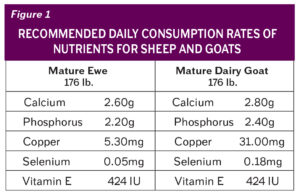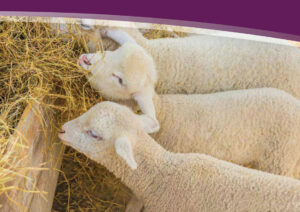Nutrient Deficiencies in Small Ruminants
Click here to view as a pdf: Nutrient Deficiencies in Small Ruminants
A balanced diet is important for the health and productivity of all livestock. This article will discuss some of the more common nutrient deficiencies/imbalances in both sheep and goats. Minerals, specifically, are all connected and work together to keep animals healthy and productive. An excess or deficiency of one can lead to imbalances in another, causing potential health issues. For example, excess calcium can cause the blood vessels to lose vascular tone and eventually rupture. Potassium works with sodium to regulate the body’s water balance. It is important to be able to identify any signs of imbalance in order to correct and prevent issues in a herd.
All nutrients have recommended feeding rates for livestock based on species, life stage, production and performance level. This article will specifically discuss calcium, phosphorous, copper, selenium and vitamin E along with the potential health issues that can arise when they are not fed at the correct amount or ratio. Figure 1 lists the recommended daily consumption rates of nutrients for sheep and goats as per the National Research Council’s edition of ‘Nutrient Requirements of Small Ruminants.’ Recommendations will vary based on the animal’s size and life stage. To learn more about the nutrient requirement differences between sheep and goats, see the article ‘The Myth of “All-In-One” Small Ruminant Feed and Mineral’ from the Crystal Creek® December 2019 Newsletter. 
Calcium and Phosphorous: Both calcium and phosphorus are critical for the proper growth, production and overall health of the animal. Sheep and goat rations should be balanced to meet the animal’s requirements, but careful attention should be paid to the vitamin and mineral ratio as well. The ratio of calcium: phosphorus should be between 1.2:1 to 2:1. Excess and/or imbalances of both can result in bladder stones, leading to urinary issues. This condition occurs commonly in male sheep and goats. While most often seen in castrated males, it can also be seen in intact rams or bucks.
Epiphysitis is another issue that can result from an improper balance of calcium: phosphorous. Epiphysitis is also called bent, or wind-swept legs. It results in bowing of the lower leg bone and can be in one or both legs. Excess calcium in the diet at a ratio of 1.8:1 or greater can lead to this disorder. Rapidly growing kids, young does that are late in pregnancy with multiple kids, or does in early lactation that milk heavily, are the most susceptible.
Copper: Copper is required for red blood cell formation, wool/coat color and texture, connective tissue development and the formation of enzymes. Copper is one of the most significant requirement differences between sheep and goats. Goats require 6x the amount of copper compared to sheep. When sheep consume copper above the required amount, the excess is stored in the liver. Once it builds up in the liver, signs of copper toxicity can occur, including dark urine due to the destruction of red blood cells, liver damage and jaundice. Even though sheep are sensitive to toxic levels of copper, the daily requirement for copper still must be met. Unlike other ruminant species, lambs have a lower blood copper level than their ewes when born. This means, if a ewe is deficient, the lamb will be born deficient or will not have enough reserves and show signs of deficiency within a few days of birth. Common signs of copper deficiency in both sheep and goats include discolored, rough hair coat, anemia, diarrhea and weight loss. Molybdenum can decrease the absorption of copper. In high molybdenum areas, extra copper may be needed.
Selenium and Vitamin E: Selenium and vitamin E are listed together because they work together to prevent and repair cell damage in the body. They also play a vital role in lamb and kid vigor at birth, muscle and bone development and immune function. Deficiencies of one, or both, selenium and vitamin E could result in a poor immune response, poor performance in youngstock, fertility issues in ewes and does and white muscle disease. Lambs and kids affected by white muscle disease appear weak with a poor suckling reflex, slow movements and arched backs when laying down. In many agricultural areas, selenium is deficient in the soil, but there are also areas with high levels. Being aware of the selenium level in your area is important. Toxic levels of selenium can result in hair loss, diarrhea and lameness.
When balancing a diet, it is important to know the minimum and maximum amounts of nutrients recommended, as there can be benefits to feeding more than the recommended daily value. Crystal Creek® utilizes NDS ration balancing software to balance rations for livestock. The program helps the nutritionist see areas of potential deficiencies or excess. Once a ration is balanced, the software program also gives potential average daily gain predictions as well as potential milk production. This is very beneficial when working with producers to meet production goals.
A properly balanced diet, along with bioavailable sources of minerals and vitamins, is required to maximize animal performance. Crystal Creek® offers both a sheep and goat mineral to meet each species-specific nutrient requirements. Custom ration balancing comes with the purchase of the mineral to ensure nutrient requirements are met for all stages of production. To learn more about the Crystal Creek® Small Ruminant Nutrition Program, call 1-888-376-6777 to speak with one of our knowledgeable nutritionists or livestock specialists.
References available upon request.


